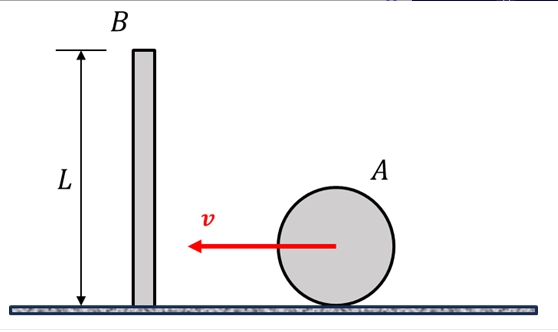QUESTION: A bowling ball ( m₁ = 3.00 kg and radius of r = 50.0 mm) which has an angular and linear velocity of 57.1 rad/s and 2.85 m/s, respectively, rolls without sliding and hits a slender Bar B of mass m_2 = 1.00 kg and length L = 0.12 m, which is initially at rest as shown in the following figure. Neglecting the friction between the sphere and the bar, and knowing the coefficient of restitution between the sphere and the bar is 0.2, determine (1) the angular velocity of Sphere A and Bar B immediately after impact, and (2) the linear velocities of sphere A and bar B immediately after impact (and at their centroids). ANSWER: Answers I got are: (they are wrong :< need help) Angular velocity of Sphere A immediately after impact: -/+ 3.34 rad/s (both are wrong) Angular velocity of Bar B immediately after impact: 8.09 rad/s The linear velocity of sphere A immediately after impact (and at the centroid) : 0.16 rad/s2 or 0.485 rad/s2 (both wrong) The linear velocity of Bar B immediately after impact (and at the centroid): 0.485 rad/s2 (the units are provided in the question) Additional Question: If the ball which has an angular and linear velocity of 57.1 rad/s and 2.85 m/s, respectively, rolls without sliding at time t. What is time t at which the ball starts to roll w/out sliding and what is the angular acceleration of the ball before time t? Sphere (m1= 3.00 kg r=50.00mm) , Initially rolls to the left with sliding until time t (linear velocity of v _0=4.00 m/s) Linear acceleration at centroid before time: t =2.45 m/s^2 coefficient of friction between sphere and floor: myu_k= 0.250, frictional force = 7.35 N
QUESTION:
A bowling ball ( m₁ = 3.00 kg and radius of r = 50.0 mm) which has an angular and linear velocity of 57.1 rad/s and 2.85 m/s, respectively, rolls without sliding and hits a slender Bar B of mass m_2 = 1.00 kg and length L = 0.12 m, which is initially at rest as shown in the following figure. Neglecting the friction between the sphere and the bar, and knowing the coefficient of restitution between the sphere and the bar is 0.2, determine (1) the angular velocity of Sphere A and Bar B immediately after impact, and (2) the linear velocities of sphere A and bar B immediately after impact (and at their centroids).
ANSWER:
Answers I got are: (they are wrong :< need help)
- Angular velocity of Sphere A immediately after impact: -/+ 3.34 rad/s (both are wrong)
- Angular velocity of Bar B immediately after impact: 8.09 rad/s
- The linear velocity of sphere A immediately after impact (and at the centroid) : 0.16 rad/s2 or 0.485 rad/s2 (both wrong)
- The linear velocity of Bar B immediately after impact (and at the centroid): 0.485 rad/s2
(the units are provided in the question)
Additional Question:
If the ball which has an angular and linear velocity of 57.1 rad/s and 2.85 m/s, respectively, rolls without sliding at time t. What is time t at which the ball starts to roll w/out sliding and what is the angular acceleration of the ball before time t?
- Sphere (m1= 3.00 kg r=50.00mm) ,
- Initially rolls to the left with sliding until time t (linear velocity of v _0=4.00 m/s)
- Linear acceleration at centroid before time: t =2.45 m/s^2
- coefficient of friction between sphere and floor: myu_k= 0.250, frictional force = 7.35 N

Step by step
Solved in 4 steps with 14 images


